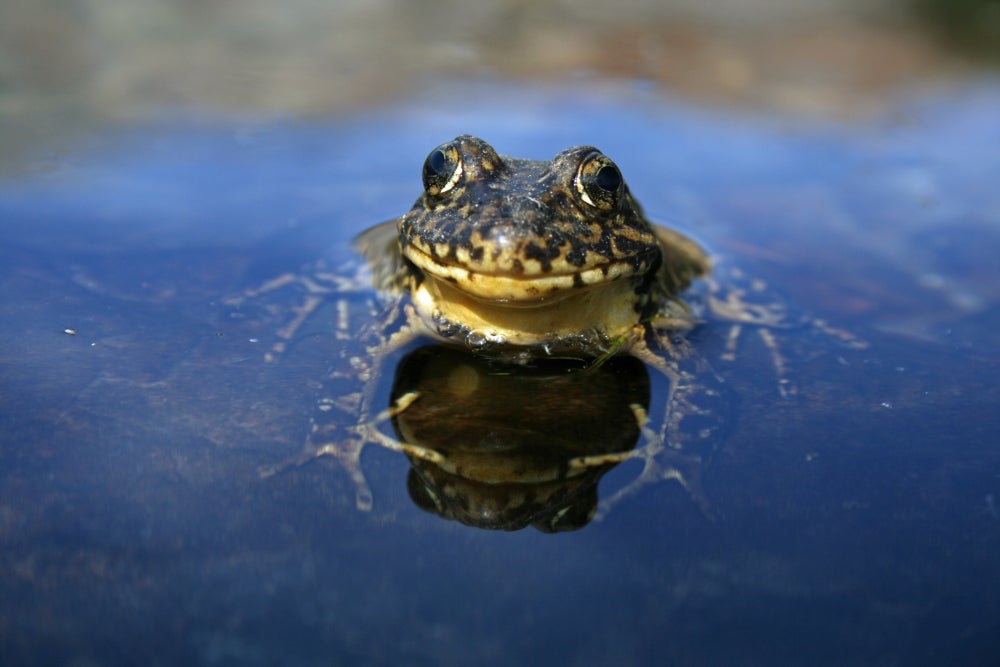
Survival Lessons
Can frogs’ ability to survive certain infections help enhance understanding of how to help humans do the same? A new research endeavor involving multiple institutions, including UC Santa Barbara, will explore that possibility.
Funded by the National Science Foundation, the partnership will examine resilience demonstrated by amphibians and other groups of species to emergence and spread of new infectious diseases, along with other human-caused changes to the global ecosystem. The team will investigate what has allowed amphibians to bounce back after disease outbreaks, using this group of species as a model for understanding how resilience comes about in other living systems.
Such is the focus of RIBBiTR, the Resilience Institute Bridging Biological Training and Research, a new center based at the University of Pittsburgh and funded by a five-year, $12.5 million grant from the NSF.
Working from UC Santa Barbara and from UCSB’s Sierra Nevada Aquatic Research Laboratory in Mammoth Lakes, co-principal investigators Cherie Briggs, Roland Knapp and Thomas Smith will focus their efforts on understanding factors driving amphibian resilience in California’s Sierra Nevada mountains, one of four ecosystems the institute will study.
“Globally, more than 500 amphibian species have declined due to the amphibian chytrid fungus, and few have shown evidence of recovery. As such, understanding the factors underlying resilience in the few amphibian species for which recovery has been documented has broad implications for the recovery of many other impacted species,” the UCSB researchers stated. “Results will also have implications for the resilience of other species and ecosystems affected by a wide variety of global stressors, including climate change.”
In the Sierra Nevada, the amphibian species of primary interest is the mountain yellow-legged frog. Once the most abundant amphibian in the Sierra Nevada, it is now extirpated from more than 90% of its historical range due in part to the spread of the amphibian chytrid fungus during the past 50 years. Remarkably, recent research indicates that the mountain yellow-legged frog is evolving increased resistance against the amphibian chytrid fungus, allowing it to recover in several portions of its range.
Briggs, a professor in UCSB’s Department of Ecology, Evolution and Marine Biology, will use data from all four of the institute’s target study systems (Panama, Brazil, the Eastern U.S., as well as the Sierra Nevada) and a range of study species to develop mathematical models to explore processes common to the many species and ecosystems represented in the BII network. She also plays a leadership role on the new institute’s executive team.
Knapp, a research biologist with UCSB’s Earth Research Institute (ERI) and Smith, an ERI assistant research biologist, also have deep expertise working with wildlife management agencies such as National Park Service, U.S. Fish and Wildlife Service and California Department of Fish and Wildlife. Public agencies are essential partners and supporters of wildlife resilience research and implementation throughout the U.S. and abroad; Knapp and Smith will share their experiences with other RIBBiTR researchers and beyond.
Pitt’s Corinne Richards-Zawacki, professor in ecology and evolutionary biology in the Kenneth P. Dietrich School of Arts and Sciences, will lead the work as principal investigator. The collaborating scientists have for years been conducting a range of research, most recently publishing in a Royal Society journal the paper, “Divergent regional evolutionary histories of a devastating global amphibian pathogen.”
“Because we have lots of data over time from around the world on amphibians who are doing better now than they were after the initial disease outbreaks, they are perfect for studying resilience,” Richards-Zawacki said. “We can ask many questions: What mechanisms make them able to live with their pathogens? Are the pathogens changing? What is the impact of different environments? If we understand how the relationship has changed between the species and the threat, we can consider how resilience can be applied to other biological systems.”
The undertaking also involves researchers at the University of Alabama; UC Berkeley; University of Massachusetts, Boston; University of Mississippi; University of Nevada, Reno; Temple University; Texas Tech University; University of Tennessee; and Vanderbilt University Medical Center.
The institute is part of the NSF’s strategy to create large research teams across disciplines and regions to investigate “rules of life” principles — fundamental life processes ranging from biomes to the Earth. This initiative aims to focus on resilience as one such “rule”, applying what they learn about the amphibians’ recovery from a newly emerged fungal to understand how other living systems can bounce back from global change stressors.
“More locally, the RIBBiTR work will support our 20-plus year efforts to document, understand, and support the resilience (recovery) of endangered frogs in California’s iconic mountain range,” noted UCSB’s Briggs, Knapp and Smith. “Our work is significant because it simultaneously contributes to academic knowledge about a range of diseases and their hosts, and it directly enhances the conservation of California’s mountain yellow-legged frogs”.
The researchers further hope to gain a better understanding of the factors underlying the resilience shown by the mountain yellow-legged frog. This includes describing the targets of natural selection that have led to increased resistance against the amphibian chytrid fungus, and how these changes in frog susceptibility have increased frog survival in the face of ongoing infection.
The collective RIBBiTR team also is charged with developing curriculum and programs that will train the next generation of biologists to employ an integrative approach to their science.
Why should we care about frogs and the like?
“Amphibians’ skins and secretions can have medicinal properties,” added Pitts’ Richards-Zawacki. “They are also canaries in the coal mine for environmental impacts, partly because they have thin skin and are exposed to contaminants both in water and on land, so they share threats with other organisms.”



